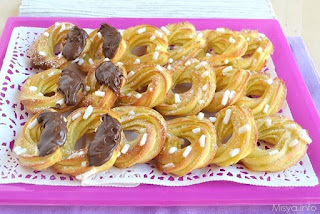SMALL PASTRIES
Small specialties in single portions such as macarons, cannoli and fruit baskets. This is the mignon pastry, a world to be discovered full of delights based on short crust pastry, sponge cake, creams, chocolate, fresh or dried fruit, jellies. Tartlets with fruit, cupcakes of various kinds, éclairs, meringues, truffles: there are many recipes for truly delicious mignon pastries. Many do not know that the word "pastry" and "mignon", in the world of confectionery art, are synonymous: there are no giant pastries, or rather, they are more modern inventions. Everything that has minute proportions and is presented in single portions can be considered part of the mignon pastry. It is an ancient art, which begins with the Arabs and with the occupation of Sicily in the early Middle Ages: thanks to the Arabs, in fact, products such as dates, pomegranate, bitter orange as well as creams and various aromas spread in Sicily. With the Arab domination, therefore, the production of the future marzipan, cassata, Sicilian cannoli began. At the same time, the production of the wafer for industrial use was spreading in France and, in the fourteenth century, this allowed the production of more elaborate and spectacular sweets. Another crucial date for the development of mignon pastry is the arrival in Italy of the recipe for amaretti, thanks to Caterina de' Medici in the mid-sixteenth century. A particular production of mignon pastries is that of the petit four (literally "small oven"), which refers to the typically French small pastry served as a dessert. But how are mignon pastries made? These are small-format delights, usually made with shortcrust pastry, choux pastry or sponge cake, or even without a base, to which creams are added, especially custard but not only, fresh, candied or dried fruit, various jellies, meringues, marzipan and so on. In our selection you can find a series of miniature pastry recipes that are simple enough to make, to fully enter this delicious world even if you are not an expert. You can prepare them for a special snack, afternoon tea, Sunday breakfast, but you can also serve them as an end to a meal, along with coffee and bitters. Among the easiest recipes, for example, that of yogurt bonbons, that of cannoli mignon, but also that of Sicilian almond pastries or Neapolitan cartridges. Macarons, éclairs and gone with the wind, on the other hand, can be slightly more complex, but I assure you that they will give you great satisfaction.
Gone with the wind: the recipe for delicious Neapolitan pastries
Ingredients
FLOUR 170 gr
BUTTER 80 gr
EGGS AT ROOM TEMPERATURE 180 gr
WATER 250 ml
CUSTARD 500 gr
POWDERED SUGAR
GRANULATED SUGAR
HAZELNUT CREAM
SALT a pinch
Preparation
Prepare the choux pastry: in a saucepan, put the butter in small pieces, water and salt. Bring almost to a boil, then remove from heat and pour in all the flour. Stir quickly with the whisk and put back on the heat. Stir over low heat with a wooden spoon , until a mass has formed that will detach from the bottom forming a white patina. Let the dough cool completely and at this point add 400 grams of cold custard and stir to mix everything. Then incorporate one egg at a time. Do not insert the next egg if the previous one has not been completely absorbed. You should get a soft but firm consistency, easy to work with the spatula. Put the dough obtained in a pastry bag with a star nozzle. Form about 25 donuts on a baking tray lined with baking paper. They should have a diameter of 6-7 cm: you will have to make them with a single round of dough. Sprinkle the gone with granulated sugar and bake at 200 ° C in a convection oven for 15 minutes, then lower to 190 ° C and continue cooking for 9-10 minutes. Once cooked, let the wind settle with the oven off slightly open for a few minutes. Remove them from the oven, let them cool completely and decorate with icing sugar and tufts of the cream set aside. Serve the Neapolitan via col vento immediately.



No comments:
Post a Comment